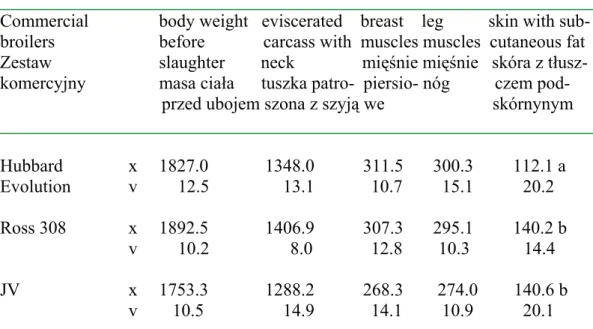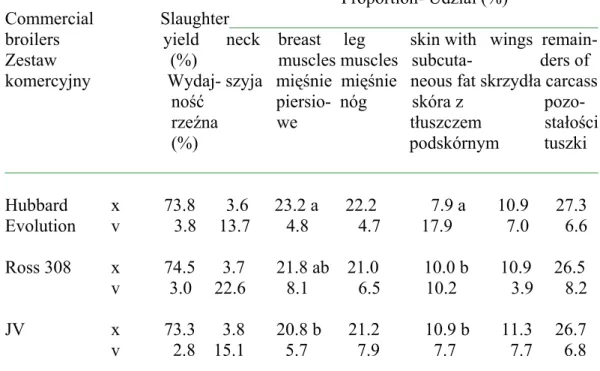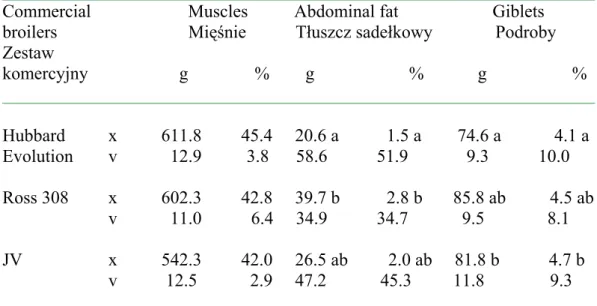COMPARISON OF SLAUGHTER YIELD AND CARCASS TISSUE COMPOSITION IN
BROILER CHICKENS OF VARIOUS ORIGIN
PORÓWNANIE WYDAJNOŚCI RZEŹNEJ I SKŁADU TKANKOWEGO TUSZEK
KURCZĄT BROJLERÓW O RÓŻNYM POCHODZENIU
DARIUSZ KOKOSZYŃSKI, ZENON BERNACKI
University of Technology and Life Sciences, Faculty of Animal Breeding and Biology, Department of Poultry Breeding,
Mazowiecka 28, 85-084 Bydgoszcz, Poland, Phone: (+) 48 52 374 97 06, Fax: (+) 48 52 322 81 58, e-mail: bernacki@utp.edu.pl Manuscript received: March 19, 2007; Reviewed: January 9, 2008; Accepted for publication: February 10, 2008
ABSTRACT
Slaughter yield and carcass tissue composition were compared in three different broiler chicken production sets. The highest body weight (1892.5 g), eviscerated carcass weight with neck (1406.9 g) and slaughter yield (74.5%) were found in Ross 308 chickens, whilst the lowest values of these traits occurred in JV chickens (respectively: 1753.3; 1288.2 g; 73.3%). The highest muscle contents (45.4% breast muscles and leg muscles in carcass) and the lowest fattiness (7.9% skin with subcutaneous fat and 1.5% abdominal fat) were found in Hubbard Evolution chickens.
KEY WORDS: broiler, Ross, Hubbard, JV, slaughter yield
STRESZCZENIE
Porównywano wydajność rzeźną i skład tkankowy tuszek trzech zestawów produkcyjnych kurcząt brojlerów
.
Największą masę ciała (1892,5 g), masę tuszki patroszonej z szyją (1406,9 g) i wydajność rzeźną (74,5%) stwierdzono u kurcząt Ross 308, a najmniejsze wartości tych cech u JV (odpowiednio: 1753,3; 1288,2 g; 73,3%). Największe umięśnienie (45,4% mięśni piersiowych i nóg w tuszce) i najmniejsze otłuszczenie (7,9% skóry z tłuszczem podskórnym oraz 1,5% tłuszczu sadełkowego) stwierdzono u kurcząt Hubbard Evolution.SZCZEGÓŁOWE STRESZCZENIE
Badania przeprowadzono na kurczętach brojlerach z trzech zestawów komercyjnych: Hubbard Evolution, Ross 308 i JV utrzymywanych w warunkach produkcyjnych. Ptaki przebywały przez cały czas odchowu w pomieszczeniu zamkniętym, bez dostępu do wybiegu, o regulowanych parametrach środowiska i kurczęta żywiono ad libitum standardowymi mieszankami treściwymi. Po 6. tygodniach odchowu z każdego zestawu produkcyjnego wybrano losowo po 12 osobników, ubito i poddano dysekcji. Największą masę ciała przed ubojem, masę tuszki patroszonej z szyją i wydajność rzeźną miały kurczęta Ross 308, a najmniejszą brojlery JV. Nie zanotowano istotnych różnic pod względem masy mięśni piersiowych oraz masy i udziału (%) nóg w tuszce między ocenianymi zestawami. Natomiast procentowy udział mięśni piersiowych w tuszkach Hubbard Evolution był statystycznie istotnie większy niż u ptaków JV. Analiza składu tuszek wykazała statystycznie istotne różnice pod względem masy i procentowego udziału skóry z tłuszczem podskórnym oraz tłuszczu sadełkowego między porównywanymi zestawami. Najmniej otłuszczone były tuszki kurcząt Hubbard Evolution, które miały także
największą zawartość (g, %) mięśni piersiowych i nóg łącznie.
INTRODUCTION
Broiler chickens with an intensive growth rate are usually slaughtered at the age of 6 weeks and this is mainly correlated with their satisfactory body weight, the size of breast muscles, low fodder intake per growth unit and the maturity of their plumage.
Broilers utilized in Poland, originating from parentage of foreign companies, are evaluated in testing stations under the standard environmental conditions. Tests have shown that broiler chickens at the age of 6 weeks reach body weight from 1.88 to 2.36 kg with varied feed intake from 1.96 to 2.23 kg of feed per kg of body weight. Breast muscle contents in the 6 week old broiler carcasses range from 21.5 to 24.0%, and leg muscles from 19.5 do 21.0% [2, 3].
Evaluation of the influence of parentage and gender on slaughter yield and tissue composition in broiler carcasses bred under production conditions was conducted recently by Adamski et al. [1] Janocha et al. [6], Gornowicz and Dziadek [4], Sengül et al. [9] and Quentin et al. [11].
Table 1. Body weight and some tissue components in carcasses in broiler chickens
Tabela 1. Masa cia
�
a i niektóre sk
�
adniki tkankowe tuszek kurcz
�
t brojlerów
__________________________________________________________________
Weight – Masa (g)
__________________________________________________________________
Commercial
body weight eviscerated breast leg skin with sub-
broilers
before carcass with muscles muscles cutaneous fat
Zestaw
slaughter neck mi
��
nie mi
��
nie skóra z t
�
usz-komercyjny
masa cia
�
a tuszka patro- piersio- nóg czem pod-
przed ubojem szona z szyj
�
we skórnynym
__________________________________________________________________
Hubbard
x 1827.0
1348.0 311.5 300.3 112.1 a
Evolution
v 12.5
13.1
10.7 15.1 20.2
Ross 308
x 1892.5
1406.9 307.3 295.1 140.2 b
v 10.2 8.0
12.8 10.3 14.4
JV
x 1753.3
1288.2 268.3 274.0 140.6 b
v 10.5
14.9
14.1 10.9 20.1
__________________________________________________________________
Substantial discrepancies between the results obtained by these authors and the results from the testing stations, as well as ongoing improvements in the quality of broiler production, indicate that there is a need for the analyses of usability of new commercial broiler sets, currently kept in production.
The aim of this work was to provide a comparison of the influence of broiler chicken parentage on their slaughter yield and tissue composition in the carcass.
MATERIAL AND METHODS
The research was conducted in the Department of Poultry Breeding, at the Faculty of Animal Breeding and Biology, the University of Technology and Life Sciences in Bydgoszcz. The research material consisted of 42-day old Hubbard Evolution, Ross 308 and JV broiler chickens purchased from Drobex Company, located in Solec Kujawski, Poland.
During the breeding time the broilers were kept in a typical production building, equipped with a climate and environment control. The birds were given commercial
feed mixtures ad libitum: the starter up to the 14th day,
the grower from the 15th to 35th day and the finisher for
the remaining time of breeding. The basic composition of feeds was consistent with the recommendations [10]. Twelve broiler chickens (six males and six females) were selected at random from each of the production sets. Carcasses were refrigerated over 18 hours in temperature of +4ºC. Dissection analysis was performed according to the Ziołecki and Doruchowski method [12]. The following was separated from the carcass: breast and leg muscles, wings, neck without skin, skin from the neck, skin with subcutaneous fat, abdominal fat and giblets (heart, muscular stomach and liver).
The results were verified statistically, including the mean values (x) and the coefficient of variation (v) of the traits. Significance of differences between the production sets (genetic groups) was verified with the variance analysis and the Duncan test.
RESULTS AND DISCUSSION
The mean body weight of 6-week old broiler chickens
Table 2. Slaughter yield and some components content in carcass in broiler chickens
Tabela 2. Wydajno
��
rze
�
na i zawarto
��
niektórych sk
�
adników tuszek kurcz
�
t brojlerów
__________________________________________________________________
Proportion- Udzia
�
(%)
Commercial Slaughter
_________________________________________
broilers yield neck breast leg skin with wings remain-
Zestaw (%) muscles muscles subcuta- ders of
komercyjny Wydaj- szyja mi
��
nie mi
��
nie neous fat skrzyd
�
a carcass
no
��
piersio- nóg skóra z
rze
�
na we t
�
uszczem sta
�
o
�
ci
(%) podskórnym tuszki
__________________________________________________________________
Hubbard
x
73.8 3.6 23.2 a 22.2 7.9 a 10.9 27.3
Evolution
v 3.8 13.7 4.8 4.7 17.9 7.0 6.6
Ross 308
x
74.5 3.7 21.8 ab 21.0 10.0 b 10.9 26.5
v 3.0 22.6 8.1 6.5 10.2 3.9 8.2
JV
x
73.3 3.8 20.8 b 21.2 10.9 b 11.3 26.7
v
2.8 15.1 5.7 7.9 7.7 7.7 6.8
__________________________________________________________________
of both sexes in Ross 308 set was 1892.5 g and it was greater by 65.5 g than in Hubbard Evolution chickens, and it was as much as 139.2 g greater than in JV broilers. Lower than that values of body weight in Hubbard and Ross chickens were obtained by Adamski et al. [1], while greater by Gawęcki et al. [2]. Also Sengül et al. [9] found greater mean body weight values in Ross (2097 g) and Hubbard (2154 g) chickens at 6 weeks of age. The heaviest eviscerated carcasses with neck (1406.9 g) were found in Ross 308 chickens, whilst the lightest in JV (1288.2 g), which resulted from the body weight achieved by these chickens prior to slaughter.
Hubbard Evolution carcasses contained more of breast and leg muscles in comparison to Ross 308 and JV chickens (Tab.1). Adamski et al. [1] has shown in his study that breast muscle weight in Hubbard chickens was greater, whilst leg muscle weight was smaller than the values obtained in our experiment and the opposite relationship was found in Ross chickens. Coefficient of variation values for breast and leg muscle weight were quite high and ranged from 10.7 to 15.1%. Ross 308 and JV chickens were fatter and the skin weight together with the subcutaneous fat in these birds was statistically significantly greater than in the Hubbard Evolution chickens.
Slaughter yields of the evaluated chicken production sets
were similar and ranged from 73.3 to 74.5% (Tab. 2). Similarly high readings of slaughter yield (from 72.0 to 77.2 %) in Ross and Hubbard chickens were received by Janocha et al. [6] and Sengül et al. [9]. Also Gornowicz and Dziadek [5], and Gawęcki et al. [2] have obtained high slaughter yield in broilers.
The highest contents (%) of breast and leg muscles (respectively: 23.2 and 22.2%) were found in carcasses of Hubbard Evolution chickens, whilst this parameter was statistically least significant in JV birds (20.8 and 21.2%). Lower values of contents by percentage of breast muscles (from 20.6 to 22.6%) and leg muscles (from 17.5 to 19.7%) in Hubbard chickens were found by Krawczyk et al. [7] and Janocha et al. [6]. However, Gornowicz et al. [5] and Janocha et al. [6] found that Ross chickens have shown greater contents of breast muscles in the carcass (from 22.7 to 24.4%), and lower or similar contents of leg muscles (from 20.6 to 21.1%). Contribution of wings in the carcass was similar and ranged from 10.9 to 11.3%, and variance oscillated from 3.9 to 7.7%. The lowest content of skin with subcutaneous fat in carcasses by percentage was found in Hubbard Evolution chickens, while the greatest in JV birds.
The highest weight and percentage of breast and leg muscles together (Tab. 3) was found in Hubbard Evolution chickens (611.8 g, 45.4%), while the lowest
Table 3. Weight and content (%) of muscles, abdominal fat and giblets in carcass
Tabela 3. Masa i zawarto
��
(%) mi
��
ni, t
�
uszczu sade
�
kowego i podrobów w tuszce
__________________________________________________________________
Commercial
Muscles Abdominal fat
Giblets
broilers
Mi
��
nie T
�
uszcz sade
�
kowy Podroby
Zestaw
komercyjny
g % g
% g %
__________________________________________________________________
Hubbard
x
611.8 45.4 20.6 a
1.5 a 74.6 a
4.1 a
Evolution
v
12.9 3.8 58.6 51.9 9.3 10.0
Ross 308
x
602.3 42.8 39.7 b
2.8 b 85.8 ab 4.5 ab
v
11.0 6.4 34.9 34.7 9.5 8.1
JV
x
542.3 42.0 26.5 ab 2.0 ab 81.8 b 4.7 b
v
12.5 2.9 47.2 45.3 11.8
9.3
_________________________________________________________________
in JV (542.3 g and 42.0%). Other authors, such as [1, 4, 6] obtained similar values of muscle contents in Ross chickens (from 43.5 to 43.7%), but Hubbard set showed values (from 38.2 to 44.1%), which were lower than in our experiment.
Weight and percentage of abdominal fat varied substantially – the highest values were found in Ross 308 carcasses (39.7 g and 2.8%) and the lowest in Hubbard (20.6 g and 1.5%). Lower contents of abdominal fat in broiler chicken carcasses were reported by Gawęcki et al. [2], Gornowicz et al. [5] and Muzaffer et al. [8]. Percentage of giblets (heart, stomach and liver) was greater in Ross 308 and JV production sets than in Hubbard Evolution chickens (tab. 3).
CONCLUSIONS
Broilers in Ross 308 production sets are characterised by the highest body mass and the highest mass of the eviscerated carcass with neck, as well as the highest slaughter value, while the lowest values of these traits were found in JV chickens. The highest contents of breast and leg muscles (g, %) and the lowest contents of skin with subcutaneous fat and abdominal fat were found in Hubbard Evolution chickens, and this indicates their greater value to the consumer in comparison to Ross 308 and JV chickens.
REFERENCES
[1] Adamski M., Bernacki Z., Kuźniacka J., The effect of origin on slaughter yield and tissue content of broiler chichens carcasses. The works of The Commission of Agricultural and Biological Sciences BTN (2004) 53, 9-16 [in Polish].
[2] Gawęcki W., Kiełczewski K., Szlinka U., Gawęcka K. E., Evaluation of usability of broiler chickens originating from various parental flocks in Poland (test no 1/2000). Evaluation results of poultry usability. National Reseach Institute of Animal Production in Krakow, (2001a) 29, 3-16 [in Polish].
[3] Gawęcki W., Kiełczewski K., Szlinka U., Gawęcka
K. E., Evaluation of usability of broiler chickens originating from various parental flocks in Poland (test no 2/2000). Evaluation results of poultry usability. National Reseach Institute of Animal Production in Krakow, (2001b) 29, 17-30 [in Polish].
[4] Gornowicz E., Dziadek K., Variation in chemical composition of breast and thigh muscles in relation to their origins. Ann. Anim. Sci., (2001) 28, 2, 89-100 [in Polish].
[5] Gornowicz E., Joachimiak A., Dziadek K., The influence of protein source used in broiler chicken nutrition on meat chemical traits. Conference materials, XVI session WPSA, Siedlce, (2004) 57 [in Polish].
[6] Janocha A., Osek M., Klocek B., Wasilowska Z., Turyk Z., Quality evaluation of broiler chickens of various genetic groups. Appl. Sci. Rep. Anim. Prod. Rev., (2003) 68, 4, 141-148 [in Polish].
[7] Krawczyk J., Cywa-Benko K., Wężyk S., The influence of wheat grain in broiler chicken nutrition. Ann. Anim Sci., Supl. (2002) 16, 229-234 [in Polish].
[8] Muzaffer D., Okan F., Celik K., Effect of dietary probiotic, organic acid and antibiotic supplementation to diets on broiler performance and carcass yield. Pakistan J. Nutr., (2003) 2, 89-91.
[9] Sengül T., Cetin M., Konca Y., Yildiz A., Comparison of growth performance and carcass yield of some commercial broilers. J. Poultry Res., (2003) 3, 1, 12-16.
[10] Smulikowska S and ass. Dietary norms for poultry. Edition III. The Kielanowski Institute of Animal Phisiology and Nutrition Polish Academy of Sciences. Jabłonna, (1996) 77-82 [in Polish].
[11] Quentin M., Bouvarel I., Berri C., Bihan-Duval Le E., Baéza E., Jego Y., Picard M., Growth, carcass composition and quality response to dietary concentration in fast-, medium- and slow-growing commercial broilers. Anim. Res., (2003) 52, 65-77.


